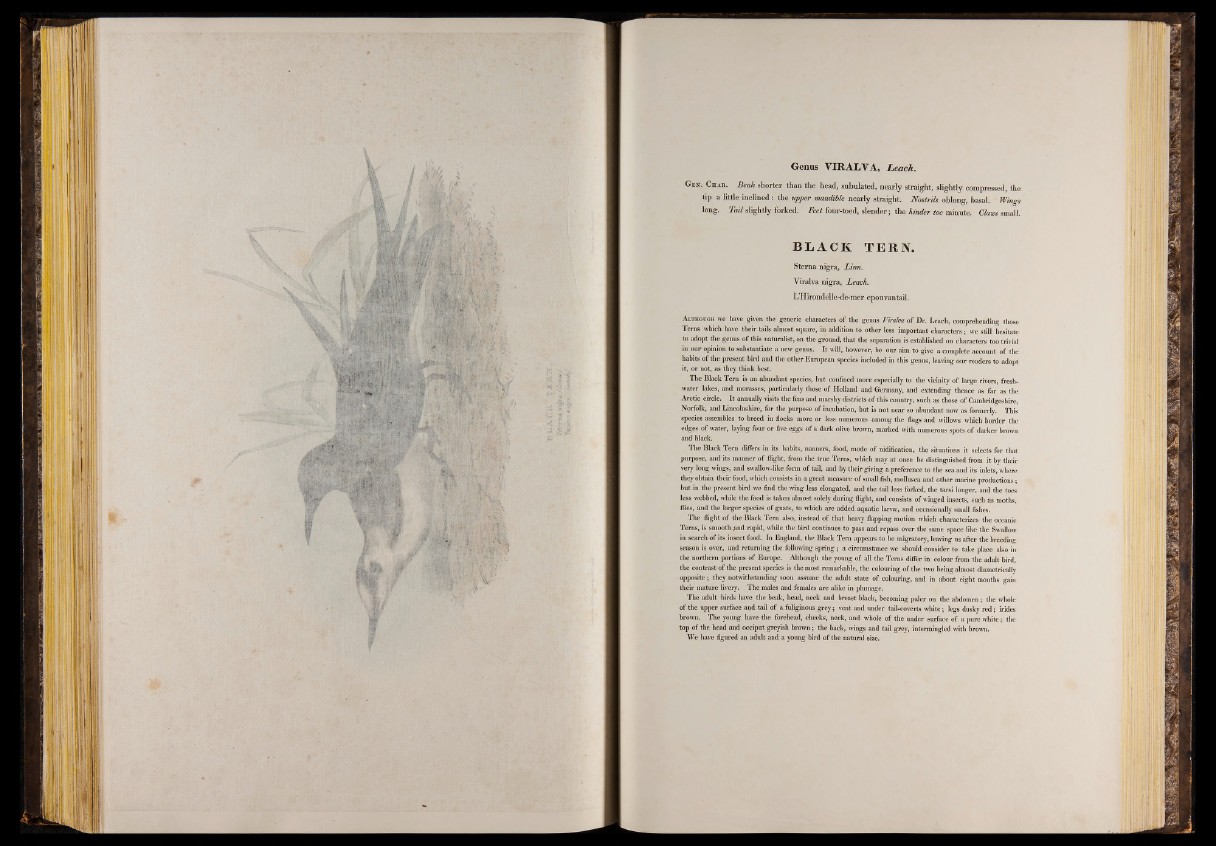
GenuB VIRALVA, Leach.
Ge n . C har. Beak sh o rte r th a n th e head, su b u lated , n e a rly straight, slig h tly compressed, the
tip a little inclined : th e upper mandible n early straight. Nostrils oblong, basal. Wings
long. Tail slig h tly forked. Feet four-toed, s le n d e r; th e hinder toe minute. Clam small,
B L A C K TERN.
S te rn a n ig ra , Linn.
Viralva n ig ra , Leach.
L ’Hirondelle-de-m er epouvantail.
A lthough we have given the generic characters of the genus Viralva of Dr. Leach, comprehending those
Terns which have their tails almost square, in addition to other less important characters ; we still hesitate
to adopt the genus of this naturalist, bn the ground, that the separation is established on characters too trivial
in our* opinion to substantiate a new genus. It will, however, be our aim to give a complete aecount of the
habits of the present bird and the other European species included in this genus, leaving our readers to adopt
it, or not, as they think best.
The Black Tern is an abundant species, but confined more especially to the vicinity of large rivers, freshwater
lakes, and morasses, particularly those of Holland and Germany, and extending thence as far as the
Arctic circle. It annually visits the fens and marshy districts o f this country, such as those of Cambridgeshire,
Norfolk, and Lincolnshire, for the purpose of incubation, but is not near so abundant now as formerly. This
species assembles to breed in flocks more or less numerous among the flags and willows which border the
edges of water, laying four or five eggs of a dark olive brown, marked with numerous spots of darker brown
and black.
The Black Tern differs in its habits, nanners, food, mode o f nidification, the situations it selects for that
purpose, and its manner of flight, from the true Terns, which may at once be distinguished from it by their
very long wings, and swallow-like form of tail, and by their giving a preference to the sea and its inlets, where
they obtain their food, which consists in a great measure of small fish, mollusca and other marine productions;
but in the present bird we find the wing less elongated, and the tail less forked, the tarsi longer, and the toes
less webbed, while the food is taken almost solely during flight, and consists of winged insects, such as moths,
flies, and the larger species of gnats, to which are added aquatic larvae, and occasionally small fishes.
The flight of the Black Tern also, instead of that heavy flapping motion which characterizes the oceanic
Terns, is smooth And rapid, while the bird continues to pass and repass over the same space like the Swallow
in search of its insect food. In England, the Black Tern appears to be migratory, leaving us after the breeding
season is over, and returning the following spring; a circumstance we should consider to take place also in
the northern portions of Europe. Although the young of all the Terns differ in colour from the adult bird,
the contrast of the present species is the most remarkable, the colouring of the two being almost diametrically
opposite; they notwithstanding soon assume the adult state of colouring, and in about eight months gain
their mature livery. The males and females are alike in plumage.
The adult birds have the beak, head, neck and breast black, becoming paler on the abdomen; the whole
of the upper surface and tail of a fuliginous grey; vent and under tail-coverts white; legs dusky red; irides
brown. The young have the forehead, cheeks, neck, and whole of the under surface of a pure white; the
top of the head and occiput greyish brown; the back, wings and tail grey, intermingled with brown.
We have figured an adult and a young bird of the natural size.